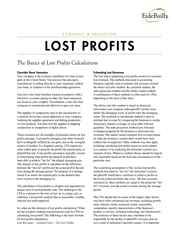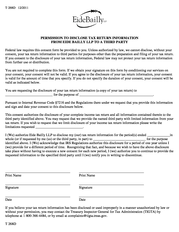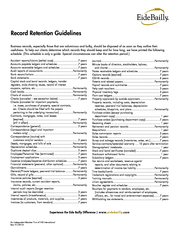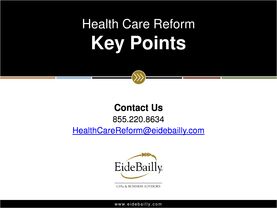Possibilities Insights for Businesses & Individuals - Retirement Planning: It’s Really About Cash Flow – October 2015
Eide Bailly
Description
4310 17th Ave S
PO Box 2545
Fargo ND 58108-2545
This publication is produced and
published by Eide Bailly and
distributed with the understanding
that the information contained does
not constitute legal, accounting or
other professional advice. It is not
intended to be responsive to any
individual situation or concerns as
the contents of the publication are
intended for general informational
purposes only. Readers are urged
not to act upon the information
contained in this publication without
first consulting competent legal,
accounting or other professional
advice regarding implications
of a particular factual situation.
Questions and information for
publication can be submitted to
your Eide Bailly representative.
To request reprints of this publication,
send a written request to
RequestReprints@eidebailly.com.
© 2015 Eide Bailly LLP.
To view this and previous
issues of POSSIBILITIES, visit
www.eidebailly.com/publications
Managing Editor: Liz Stabenow
Assistant Editor: Clinton Larson
Send comments to:
possibilities@eidebailly.com
An Independent Member Firm
of HLB International
Resurrecting Depreciation Provisions
The higher deduction levels of Section 179, along
with the bonus depreciation provision, expired
December 31, 2014, as did approximately 60 other
tax extender provisions. While tax legislation can be
challenging to predict, recent events have given us
some glimmer of hope that the lapsed depreciation
provisions will be resurrected and even improved.
Legislative Movement
The House of Representatives passed a bill in
February 2015 to make the lapsed Section 179
provisions permanent, including indexing the
$500,000 maximum allowance and the $2 million
phase-out threshold for inflation starting in 2016.
More recently, two new pieces of legislation have
been introduced in the House.
One increases bonus depreciation from 50 percent to 100 percent, and both make bonus depreciation permanent, mirroring legislation passed in the House during the last Congressional session but failing to get Senate attention. In June, the Senate Finance Committee broached the topic of tax extenders and decided to extend 52 lapsed tax provisions, generally with a two-year extension through 2016 and retroactive application back to January 1, 2015. Items included were the extension of 50 percent bonus depreciation; extension www.eidebailly.com of the expensing limit of eligible Section 179 property to $500,000, as well as investment-based phase-out amount to $2 million and an expanded definition of what qualifies as Section 179 eligible property; an election to accelerate AMT credits in lieu of additional first-year depreciation; continued allowance of accelerated depreciation for business property on an American Indian reservation; and the 15-year recovery periods for qualified leasehold improvement property, qualified retail improvement property and qualified restaurant property. Decision Could Come Soon Although the lapsed depreciation provisions seem likely to be extended again, permanency of bonus and Section 179 provisions are still in question and will await full Congressional action, anticipated this fall. Hopefully, this will save taxpayers and the IRS from the recent tradition of tax extender passage agony in the final week of December, if not later. C O N TA C T Julie Helms Cost Segregation Senior Manager 612.253.6511 jhelms@eidebailly.com .
One increases bonus depreciation from 50 percent to 100 percent, and both make bonus depreciation permanent, mirroring legislation passed in the House during the last Congressional session but failing to get Senate attention. In June, the Senate Finance Committee broached the topic of tax extenders and decided to extend 52 lapsed tax provisions, generally with a two-year extension through 2016 and retroactive application back to January 1, 2015. Items included were the extension of 50 percent bonus depreciation; extension www.eidebailly.com of the expensing limit of eligible Section 179 property to $500,000, as well as investment-based phase-out amount to $2 million and an expanded definition of what qualifies as Section 179 eligible property; an election to accelerate AMT credits in lieu of additional first-year depreciation; continued allowance of accelerated depreciation for business property on an American Indian reservation; and the 15-year recovery periods for qualified leasehold improvement property, qualified retail improvement property and qualified restaurant property. Decision Could Come Soon Although the lapsed depreciation provisions seem likely to be extended again, permanency of bonus and Section 179 provisions are still in question and will await full Congressional action, anticipated this fall. Hopefully, this will save taxpayers and the IRS from the recent tradition of tax extender passage agony in the final week of December, if not later. C O N TA C T Julie Helms Cost Segregation Senior Manager 612.253.6511 jhelms@eidebailly.com .
Personal Finance Presentations
+
Personal Finance Sub Categories
Eide Bailly













